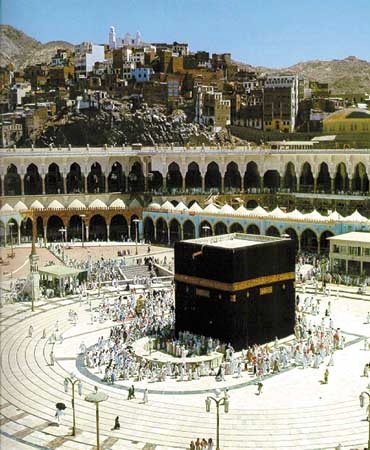Kaʿbah
shrine, Mecca, Saudi Arabia
also spelled Kaaba
 small shrine located near the centre of the Great Mosque in Mecca and considered by Muslims everywhere to be the most sacred spot on Earth. Muslims orient themselves toward this shrine during the five daily prayers, bury their dead facing its meridian, and cherish the ambition of visiting it on pilgrimage, or hajj, in accord with the command set out in the Qurʾān.
small shrine located near the centre of the Great Mosque in Mecca and considered by Muslims everywhere to be the most sacred spot on Earth. Muslims orient themselves toward this shrine during the five daily prayers, bury their dead facing its meridian, and cherish the ambition of visiting it on pilgrimage, or hajj, in accord with the command set out in the Qurʾān.The cube-shaped structure is roughly 50 feet (15 metres) high, and it is about 35 by 40 feet (10 by 14 metres) at its base. Constructed of gray stone and marble, it is oriented so that its corners roughly correspond to the points of the compass. The interior contains nothing but the three pillars supporting the roof and a number of suspended silver and gold lamps. During most of the year the Kaʿbah is covered with an enormous cloth of black brocade, the kiswah.
Located in the eastern corner of the Kaʿbah is the Black Stone of Mecca, whose now-broken pieces are surrounded by a ring of stone and held together by a heavy silver band. According to tradition, this stone was given to Adam (Adam and Eve) on his expulsion from paradise in order to obtain forgiveness of his sins. Legend has it that the stone was originally white but has become black by absorbing the sins of the countless thousands of pilgrims who have kissed and touched it.
Every Muslim who makes the pilgrimage is required to walk around the Kaʿbah seven times, during which he kisses and touches the Black Stone. When the month of pilgrimages (Dhuʾl-Hijja) is over, a ceremonial washing of the Kaʿbah takes place; religious officials as well as pilgrims take part.
The early history of the Kaʿbah is not well known, but it is certain that in the period before the rise of Islam it was a polytheist sanctuary and was a site of pilgrimage for people throughout the Arabian Peninsula. The Qurʾān says of Abraham and Ishmael (Ishmael ben Elisha) that they “raised the foundations” of the Kaʿbah. The exact sense is ambiguous, but many Muslims have interpreted the phrase to mean that they rebuilt a shrine first erected by Adam of which only the foundations still existed. The Kaʿbah has been destroyed, damaged, and subsequently rebuilt several times since. In 930 the Black Stone itself was carried away by an extreme Shīʿite sect known as the Qarmatians and held almost 20 years for ransom. During Muhammad's early ministry, the Kaʿbah was the qiblah, or direction of prayer, for the Muslim community. After the Muslim migration, or Hijrah, to Medinah, the qiblah briefly switched to Jerusalem before returning to the Kaʿbah. When Muhammad's forces conquered Mecca in 630, he ordered the destruction of the pagan idols housed in the shrine and ordered it cleansed of all signs of polytheism. The Kaʿbah has since been the focal point of Muslim piety.
- White Island
- White, John
- White, Joseph Blanco
- Whitelaw Reid
- white lead
- White, Leonard Dupee
- White, Leslie A.
- Whiteley, Brett
- Whitelocke, Bulstrode
- White Lotus Rebellion
- Whiteman, Paul
- white mica
- White, Minor
- White Mountain, Battle of
- White Mountains
- White Nile River
- white noise
- white oak
- White, Patrick
- White, Pearl
- White Plains
- White River
- White Rock
- White Russia
- White Sands National Monument